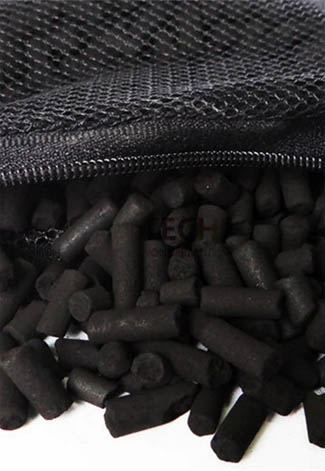Why Do You Need Aquarium Chemical Filtration?
Summary: you'll get rid of the stink, yellow water & heavy metal (apologies to Metallica fans)

Chemical filtration in an aquarium is the process of removing unwanted contaminates by using chemical compounds. There are three main types of chemical filtration products: carbon, phosphate remover, and resin. Each has unique benefits and a different manner for use in an aquarium.
Carbon
Carbon is the most common form of chemical filtration. It is included in small amounts in most power filters, canister filters, and built-in filters. This carbon, which comes from charcoal, is typically activated carbon. This means the charcoal has been heated or otherwise treated to increase its adsorptive power. This activation makes the carbon extremely reactive to other chemicals. These chemicals attach themselves to the surface of the carbon in a process known as adsorption. Once the compounds are attached to the carbon they are removed from the water.
Carbon doesn’t remove primary toxic compounds like ammonia and nitrate. Instead, carbon is a great way to remove odors and discoloring compounds from the water. If you notice that your aquarium has a smell, or your water has a tint to it, carbon can help. Carbon can be used in any aquarium and is the easiest way to improve water clarity.
The best way to use carbon is in a dedicated reactor. A carbon reactor such as the
Two Little Fishies Phosban Reactor 150 will hold a large amount of carbon and pump water directly through the carbon.
We carry a
Reactor 150 Carbon Package with all the needed components.
When using carbon be sure to use a media bag or sponges to hold it in place so it does not grind itself up.
All carbon should be rinsed before use, as carbon dust can be unhealthy for fish. If your carbon is in a bag, simply rinse the bag under the sink before putting it in your filter. If you are using carbon in a reactor, then run the outlet hose of the reactor into a small bucket until the water coming out of the reactor runs clear.
Most aquarists replace carbon once a month or bi-monthly. However, carbon is typically exhausted in a week or less. It can get expensive to replace carbon once a week. The alternative is to just have carbon in the tank a couple days a month or run a carbon reactor a couple days a month.
We sell
dozens of carbon products. You can bag your own carbon using
Acurel or Inland Seas Media Bags.
Further Reading: Media Reactor Overview
Phosphate Remover
Phosphate removers are specifically designed to remove phosphate. High phosphate levels can lead to brittle corals, slow-growing corals, and algae growth. There are two main types of phosphate removers: iron oxide and aluminum oxide.
Iron oxide usually comes in small granules and is known as
GFO. GFO is great for maintaining low phosphate levels in an aquarium. However, if you have extremely high phosphate levels it can become exhausted very quickly.
For very high levels of phosphate, aluminum oxide is a better choice. The most common aluminum oxide product is
Seachem PhosBond. Once your levels are low, it is best to switch back to GFO to maintain phosphate levels.
The most efficient way to use a phosphate remover is in a dedicated media reactor. You can use aluminum oxide removers in a media reactor just as you would carbon, but when you use GFO the media should NOT be tightly packed between sponges or in a media bag. Instead, the media should be tumbled in a reactor so the surface of the media in your media reactor looks like it is dancing. This will ensure there is no channeling of water through the media. You can use a ball valve with your reactor to dial in the flow for the correct tumble.
If you do not use a media reactor, you can place your media in a media bag and then in a canister filter or filter chamber. Just like carbon, phosphate removers should be rinsed before use. Phosphate removers can last from 1-3 months and should be replaced when phosphate levels start to rise again.
Resins
Resins encompass a wide variety of filter media. Some popular options include
Chemi-Pure,
ClearFX, and
Purigen. These resins are unique chemical compounds that absorb waste. Unlike carbon and phosphate removers, these resins can remove major waste compounds like ammonia, nitrite and nitrate. Resins generally last longer than other chemical filtration media, but they are often significantly more expensive. It is also common to mix filter resins with carbon and phosphate removers such as
Pro Clear FX and
Chemi-Pure Blue.
Because resins are unique to each manufacturer, make sure to follow the manufacturer’s instructions on how to use their resin. In general, resins come pre-bagged and should be rinsed before use. Resins can then be placed in a media reactor or filter. Most resins will last for 3-6 months before needing replacement. Some resins such as
Seachem Purigen can be recharged and reused.




























